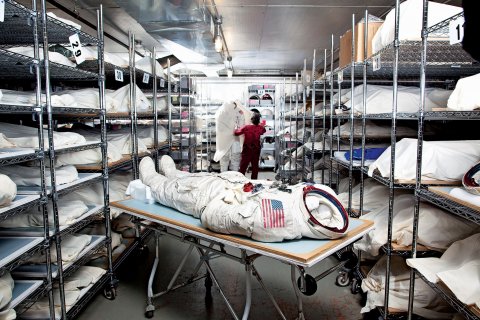For nine long years, scientists at NASA, Johns Hopkins University and the Southwest Research Institute waited for their piano-sized New Horizons space probe to pass by Pluto. It finally reached the dwarf planet last month and beamed photos back to Earth from billions of miles away. The stunning images captivated the scientific community, revealing ice mountains, frozen tundras and other never-before-seen details on Pluto's surface. Stunning, that is, if the scientists are telling the truth.
There's a small but vocal group of conspiracists—bloggers have taken to calling them "Pluto Truthers"—who claim the recent images are fake. In fact, they argue, New Horizons is simply the latest bogus galactic mission to deceive the public, perhaps to divert tax money to more secretive or nefarious government projects. That trickery is nothing new, they charge; it goes all the way back to the first moon landing.
Initial close-up images of Pluto came to Earth days before the flyby, prompting a San Diego man, who goes by Crrow777 on YouTube, to post a video about why he thought the images were fake. He argued that photos he'd taken of Jupiter with his telescopic camera from 484 million miles away were of a better quality than NASA's shots of Pluto from a distance of only a few million miles.
"This is silliness and games, and they are literally robbing the American people and then lying to them," he says in the video, adding that the space probe is "probably sitting in a Burbank, Hollywood, soundstage somewhere." He concludes, "If you want to see the real Pluto, I'm sorry to say, you've got to go to Disneyland."
The seven-and-a-half-minute clip has garnered more than 90,000 views. (His channel, which also features videos about last year's Rosetta comet landing and UFOs crossing the moon's surface, has more than 4.8 million total views and 43,000 subscribers.) In a follow-up to the Pluto video, he uses Photoshop to invert the colors and boost levels on NASA's Pluto image to show what he calls a "ghost image" of "artifacts" around the dwarf planet. On his image of the moon, by comparison, there are no artifacts.
"This is a constructed image. That's really all there is to it," he says of NASA's photograph. "There is no spacecraft out there. What we know of Pluto is that it is a very, very dim light in the sky. That is all we know of Pluto."
Crrow777 isn't the only one calling it baloney. Kedrick Blessed (real name), a 30-year-old computer engineer in California, says he grew up wanting to be an astronaut—until he stopped believing that NASA had the technology to go into space. "Anybody can go on the computer and create those," he says of the Pluto images. "There's no radiation lines.... There's no stars." NASA claims to do missions such as New Horizons, he says, only to build popularity for the agency.
Justin Shaw of Lethbridge, Alberta, says there is no doubt in his mind that the flyby images are computer-generated. "The whole mission is fallacious. There's no authenticity to this at all," he says. "People don't think twice about it." He adds, "I'm not sure what their motive would be to be faking it, other than deception. We have a lot of tax money that's disappearing for who knows what reason."
Like other Pluto Truthers—a term he says he dislikes—Shaw is skeptical of the entire space program, not just New Horizons. His theory goes: If space is a vacuum, how could spacecraft traverse it? And if it is not a vacuum, it's probably full of debris, and why would governments waste money sending people and high-tech gear into that sort of danger zone? But before people can consider those questions, Shaw says, they must rethink even basic teachings, such as whether the Earth is round and in rotation. "I'm tired of the lies and the deception that they're playing against us," he says.
Then there are Truther Truthers. Richard Hoagland, a former NASA consultant and co-author of the 2007 New York Times best-seller Dark Mission: The Secret History of NASA, believes that people like Crrow777 are NASA plants hired to keep the public from looking too closely at the Pluto images and seeing what they reveal: evidence of alien life. The Pluto Truther movement, he says, is "like a political counterforce designed to confuse people...to get people who are taking these images seriously and looking at them to basically dismiss what's on them."
Hoagland, whom one space skeptic calls "the granddaddy of the whole space 'Truther' thing," believes that NASA's imagery of Pluto, Mars and the moon shows geometric patterns that are actually the ruins of extraterrestrial civilizations. The only reason the public isn't freaking out about the evidence, he says, is that the government has not announced it yet. He points to a 1960 document, known as the Brookings Report, that NASA commissioned. It recommends the agency consider withholding information about alien life from the public to avoid a panic.
"They are really, really terrified that societal fabric will unravel," Hoagland says. Eventually, when it deems us ready, NASA will point out what the Pluto images truly show. "Those are not mountains. Those are not craters. Those are geometric, manufactured things left by somebody in an amazingly well-preserved state."
Congress formed NASA in 1958, and mistrust of the agency soon followed. (Some people quip it stands for Never a Straight Answer.) Space conspiracies run the gamut, from the belief that all astronauts are actors and that humans have never really space-traveled to claims of UFO sightings and government cover-ups. According to a 1999 Gallup poll, 6 percent of Americans believe the government faked the Apollo moon landing ("That's one small step for a man..."), perhaps to help the U.S. win the Cold War. Others believe Stanley Kubrick directed Neil Armstrong's giant leap on a film set. (The critically acclaimed 2012 documentary Room 237 is, in part, about how Kubrick's The Shining is filled with clues about this cover-up.) Conspiracy videos about the Mars Pathfinder and the Mars Curiosity rover, robotic spacecraft that, according to NASA, landed on Mars in 1997 and 2012, respectively, have millions of views on YouTube.
Still, the skeptics remain in the minority. According to the Pew Research Center, 73 percent of Americans viewed NASA favorably in 2013. (Only 22 percent now view Congress that way, Pew says.) In 2014, nearly a quarter of Americans felt the government was spending too little on space exploration, the highest percentage of any year since the General Social Survey first posed the question in 1973.

That might be why the Pluto Truthers experience so much backlash. Crrow777 says he has become a target, and for that reason he asked Newsweek to not print his real name. "People would be surprised to learn just how much anger and hatred are leveled against people for simply making video clips with a different point of view," he says. He's been "stunned at the level of malice. Even people who said they lived in my area and would find me—and all because of video clips."
Psychologists have studied what makes conspiracists tick. Stephan Lewandowsky, a cognitive scientist at England's University of Bristol who published a paper about "conspiracist ideation" in Psychological Science, told Salon in 2013 that individuals believe such theories because "it gives people a sense of control" over "randomness." In his research, Lewandowsky found that conspiracy theories tend not to exist in isolation—someone who doubts the moon landing may also believe the FBI killed Martin Luther King Jr., for example—and that theories can even influence people who don't believe them. As he and his co-authors point out in their article, "The spread of conspiracy theories about the alleged risks from vaccinations has been linked to reduced vaccination rates."
Lewandowsky has also noted why it's so hard to get through to conspiracy theorists—they often claim that evidence contrary to theirs only further demonstrates that a conspiracy exists. Psychologists call that logic a "self-sealing nature of reasoning." Maybe that's why, despite being overwhelmingly outnumbered, the Pluto Truthers feel a momentum gathering.
"We live in an age of power and deception," says Crrow777. "I do see a difference in the number of people who are no longer blind to this fact. An awakening is, in fact, under way in this regard."
Scientists don't seem too concerned with the so-called awakening. Representatives for New Horizons and three separate astrophysicists wouldn't agree to discuss Pluto Truthers. Jonathan McDowell, an astrophysicist at the Harvard-Smithsonian Center for Astrophysics, says, "It's difficult to respond in detail to statements that make no sense."
"This is a tiny group of fringe people who no one would have ever heard of if it weren't for the Internet," says Phil Plait, an astronomer who has worked with NASA and runs Bad Astronomy, a website that debunks space-related misconceptions. "There are probably just as many people who think cats don't exist."
Or are those responses just part of the cover-up?






















